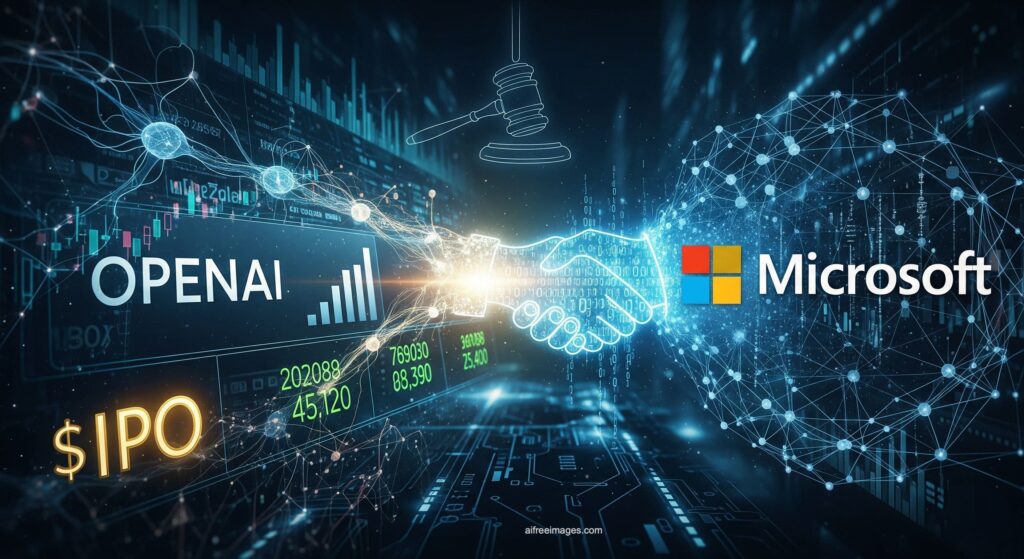The possible OpenAI IPO, still in negotiations and with open issues in its relationship with Microsoft, has become one of the most sensitive topics for the future of artificial intelligence and the global cloud market. It’s not just about raising capital or setting valuation on Wall Street: what’s at stake is control of Artificial General Intelligence (AGI) and how it will be integrated into the infrastructure of major hyperscalers — Microsoft Azure, Amazon Web Services (AWS), and Google Cloud.
AGI: the clause blocking the agreement
According to Financial Times, the main obstacle in the talks between Microsoft and OpenAI is the so-called “AGI clause”. The current contract allows OpenAI to retain any model it considers AGI without sharing it with Microsoft, even if Microsoft has funded much of its development.
For Microsoft, exclusion would be unacceptable: if AGI appears and isn’t part of Azure, it would lose what could be the most competitive advantage in cloud history. On the other hand, for OpenAI, maintaining this clause is a matter of technological sovereignty, preventing such a major breakthrough from being controlled by a single corporate giant.
Microsoft: strategic investment and Plan B
Since 2019, Microsoft has invested more than $11 billion in OpenAI, becoming its main technology partner and integrating its models into Copilot, Office, and Azure. The deal guarantees it a 49% share of the profit division of OpenAI’s for-profit arm, along with infrastructure exclusivity.
But the landscape is shifting. Microsoft is now developing its own models, such as MAI-1-preview and the recently unveiled MAI-Voice-1, in an effort to reduce dependency and maintain leadership even if the relationship with OpenAI deteriorates.
Hyperscalers: the cloud as battleground
The other major point of friction is the Azure exclusivity. OpenAI wants to be able to offer its services on AWS and Google Cloud, which would expand its reach and diversify API revenue.
For Microsoft, ceding this ground would mean losing a strategic monopoly at a time when generative AI is becoming the killer app of the cloud. Analysts see here a clash of interests:
- AWS: could integrate OpenAI into its Bedrock ecosystem and strengthen its leadership in the cloud market.
- Google Cloud: with Vertex AI and Gemini, aims to regain ground after falling behind in the widespread adoption of generative AI.
- Azure: risks losing its competitive edge if OpenAI breaks the exclusivity.
The outcome will not only determine OpenAI’s IPO but also the balance of power among hyperscalers for the next five years.
An IPO with a lot at stake
Beyond the clauses, the OpenAI exit to the public markets is seen as inevitable to sustain its costs, which are estimated at billions of dollars annually for training and serving models like GPT-5.
SoftBank has committed $10 billion, but conditioned on Microsoft and OpenAI reaching an agreement before the end of 2025. A successful IPO would allow OpenAI to:
- Secure resources for training future frontier models.
- Retain talent in a highly competitive market.
- Diversify its investor base and reduce dependency on Microsoft.
However, failure in negotiations could force OpenAI to give up more equity to Microsoft, completely changing the power balance in its strategy.
A bubble in AI?
Sam Altman himself has warned that an AI bubble could form, and a delayed IPO might be risky if the market begins to lose confidence in short-term profitability. For many investors, the key is the promise of AGI: if OpenAI convinces that it’s closer than anyone else to achieving it, its IPO will be historic. If not, it will face doubts similar to those faced by other tech giants during the hype cycle.
Conclusion: a race that will define the future of AI
The dispute between Microsoft and OpenAI is not just contractual: it’s a reflection of the battle to control the infrastructure of future AI. What’s at stake includes:
- AGI as a strategic global asset.
- The dominance of hyperscalers in AI cloud infrastructure.
- The success or failure of an IPO that could shape the next decade of technology.
In this game, both OpenAI and Microsoft know that breaking the rules would be suicidal. But ceding too much would also be unwise. The market watches silently, aware that whatever is decided will mark the history of artificial intelligence.
Frequently Asked Questions (FAQ)
1. What’s the difference between generative AI and AGI?
Generative AI creates text, images, or audio from trained data, while AGI would be capable of reasoning and learning autonomously, with capabilities similar or superior to humans.
2. Why does Microsoft insist on Azure exclusivity?
Because OpenAI’s integration has allowed it to differentiate its cloud from AWS and Google Cloud. Losing this exclusivity would reduce its competitive advantage.
3. What role do SoftBank and other investors play?
SoftBank has pledged $10 billion, but only if the OpenAI-Microsoft deal closes before the end of 2025. Other funds await clarity before committing capital to an IPO.
4. How would this negotiation impact the cloud market?
If OpenAI manages to offer services on AWS and Google Cloud, it would shift the competitive balance in the sector, eroding Azure’s edge and potentially triggering a price and capability war in AI cloud services.

